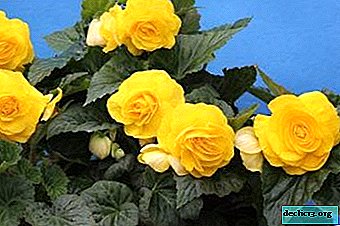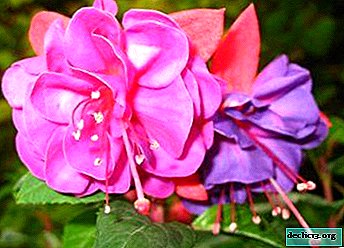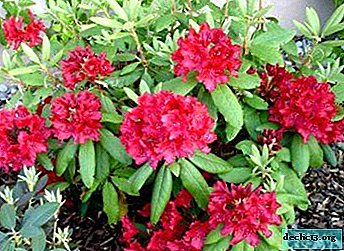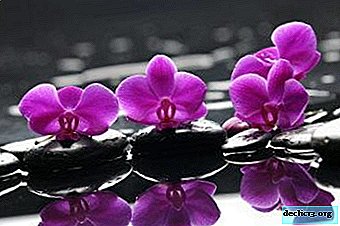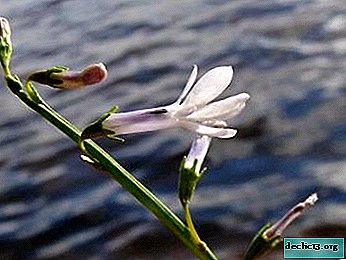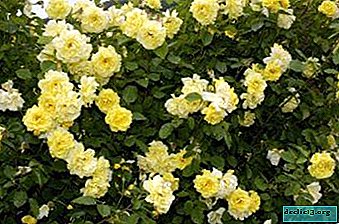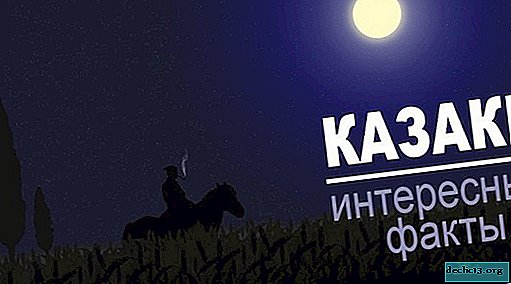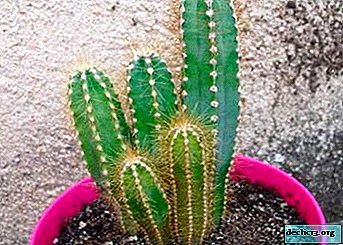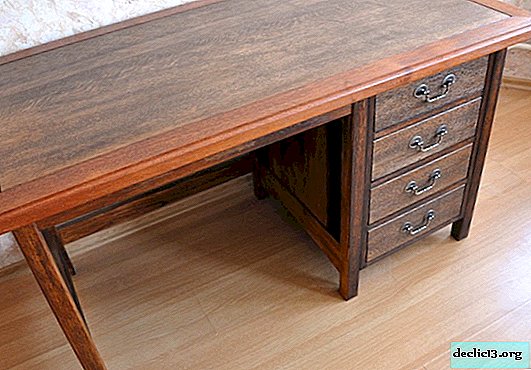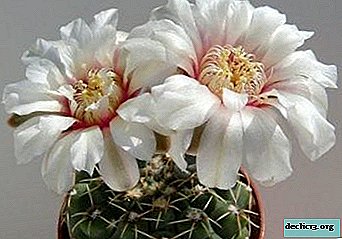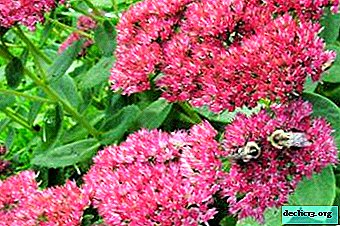Description and photos of varieties Lashenalia, as well as the difficulties of caring for a capricious plant
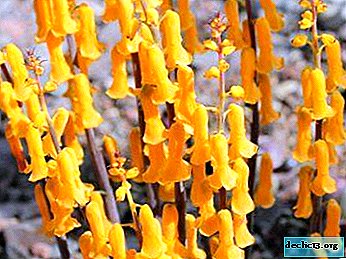
This unusual plant is as if created to surprise and delight. Its flowering resembles a garland of bright, like lights, bells.
And this garland is lit in the freezing winter, as if reminds that in the midst of severe cold there is always a place for warmth and coziness.
It is difficult to imagine how many species of plants can be found in the collections of amateur gardeners. Some like the unusual colors and shape of the leaves, others like chic buds, the third is important for the minimum amount of effort spent on care. Lashenalia does not suit people lazy and inattentive - this beautiful flower requires special conditions and care.
Botanical Description and History
Lachenalia (Lachenalia) - also lachenalia, Cape primrose. Representatives of this family are bulbous herbaceous perennial plants belonging to the Asparagus family.
A flower-bearing shoot of a cylindrical shape, an inflorescence in the form of an ear or a brush. Sepals and petals have different shades: from green to lilac. The base of the perianth is tubular at the base, gradually turning into a bell-shaped. Divided into several parts (most often 6), internal longer than external. Stamens narrowed, filiform, in the amount of 6 pieces. The ovary is free, three-pronged. The upper part of the pestle is capitate. Flowering lasts a month.
Lanshenalia fruit looks like a three-edged box. Ripening - cracking at the seams, opening the passage to numerous seeds. The seeds are small, 1.5 ml in diameter, bulbous, black, with a shiny smooth surface.The leaves are oblong-sternate, linear, most often 2 (less often - 10), collected in a socket. Glossy, often have brown or purple spots on top, brown warts, white stripes. The base of the leaf is covered by scales of a filmy appearance.
Bulbs are oblate or spherical, lemon and brown scales, closed, with a diameter of up to 3 cm. 4 flower arrows can grow from a large bulb. The aroma of flowers is pleasant, barely perceptible. In wild conditions, hummingbirds are engaged in pollination; some species have self-pollinated flowers.
The height of an adult plant varies from 12 to 40 cm. They have a long life cycle. There are 100 varieties in the genus. For home breeding, only 15 species were bred, on the basis of which several dozen hybrid varieties were cultivated.
Main varieties: description of appearance and photo
Aloid (Aloides), tricolor

This is the most popular species grown by gardeners. The leaves are fleshy, up to 20 cm long, dark green in color with brown spots. Outwardly similar to aloe leaves, taper up. Inflorescences are bright, develop on long peduncles and are collected in brushes. Pedicels are short. The buds are red, blooming from the bottom up in the winter months. The flowers are yellow with a splash of purple or pink, drooping, tubular, with bent green teeth.
In the wild, this kind of rarity. Hybrid forms are:
- Goldzonne.
- Harlequin.
- Naida.
- Ortenburg
- Po.
Bulbiferous (Bulbifera) or bulbous (Pendula)

It blooms from late December to March. Color - orange, raspberry, scarlet, with tips of purple or green. Height - from 10 to 25 cm. This species has two belt-like-lanceolate leaves 5 cm wide. Internal and external perianth lobes of equal length, wheat-golden. It has the largest bulbs in the genus. It grows in coastal areas and on sandy shores.
Contaminated (Contaminata)

The popular name is wild hyacinth. The height of this bulbous perennial is 25 cm. The stem is loose, straight. The name "contaminated" is due to burgundy and brown blotches on snow-white flowers. In the wild, it grows only on the Western Cape of South Africa.
Growing and propagating in the apartment
Landing is best started in late August - early September, because at this time the rest period ends.
At home, lashenalia lives no more than 8 years.How to prepare the ground?
Basic soil requirements: lightness, moderate humidity, nutrition. Looks like a mixture of sand with garden loam and pine bark for open ground, and for indoor plants - store substrate for bulbous with the addition of turf and leafy soils.
Seeds
Reproduction by seeds is not the best option. On sale, they are rare, expensive, and can only please bloom in a couple of years.
Laushenalia seeds can only be bought at specialized gardening stores. Their packaging should be intact, have information about the plant and characteristics. Ask the seller for certificates indicating the germination dates and validity of the analysis. It is pointless to take stale seeds - the germination rate will be low.
 If the seed material was obtained directly from the plant - it must be planted immediately after collection. Otherwise, it will not germinate. Step-by-step landing instructions:
If the seed material was obtained directly from the plant - it must be planted immediately after collection. Otherwise, it will not germinate. Step-by-step landing instructions:
- A low wide container must be filled with sand and peat substrate.
- Deepen the planting material into the soil by 2-3 millimeters at a distance of 3-4 centimeters from each other.
- Cover the container with glass or cling film and place in the area of diffused light.
- Watering should be regular (1 time per week - 1 glass of water). Room temperature - at least 18 degrees. Need daily airing.
- The first leaflet forms in about 20-30 days, and under the surface of the soil is the entire part of the sprout. After the appearance of seedlings, the container must be placed under intense lighting.
Bulbs
When propagated by daughter bulbs, the plant grows more magnificent, and blooms faster than when grown from seeds. But this is done only at a certain period - at the beginning of autumn.
Bulbs should be firm and smooth, with smooth lines.Plant them according to the following scheme:
- The selected children are separated from the mother and placed in the prepared sod-leaf soil mixed with peat and sand. The diameter of the pot is at least 15 centimeters.
- For the splendor of the bush, 5-9 pieces are planted immediately. Bulbs are buried completely in the ground.
- Top soil is compacted and sprinkled with a thin layer of washed gravel or expanded clay. Drainage is also placed at the bottom.
- The pot is placed in a cool, bright place. It is watered abundantly with warm purified water.
Cuttings
The best way to reproduce. Leaves are selected visually healthy. Flowering is observed after a year.
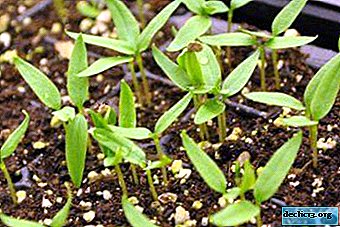 The leaf stalk is separated from the base just below the level of the substrate, cut at the base or cut in half.
The leaf stalk is separated from the base just below the level of the substrate, cut at the base or cut in half.- The material is dripped into wet coarse sand to a depth of 3-4 centimeters and placed in a warm, well-lit place.
- Sprouted small bulbs (usually 1 to 3) begin to sprout in a month and a half.
Outdoor conditions
For proper growth of lashenalia, the landing site is selected with protection against direct blowing by the winds. The landscape should be smooth, without slides and pits, with good circulation of water and air. Preparation begins in August. The place is cleaned of the root systems of other plants, digged up, fertilized with humus, superphosphates, fertilizers with magnesium sulfate and potassium.
High beds are poured and drainage is used if groundwater is located nearby. To protect against moles and insects, a landing net is used.
Bulb planting begins in late September - early October, so that they can take root before the cold. If necessary, the landing dates can be extended until November, but in this case, the site must be insulated in advance. The ground is covered with a layer of peat, and spruce branches, fresh sawdust and dry foliage are poured on top.
Seeds are sown in autumn in loose soil and covered with a thin layer of sand. The first sprouts appear within 5 weeks.
As a horticultural culture, lashenalia cannot be grown in central Russia. Too cold climate and temperature changes will destroy the plant.What to do if the plant does not take root?
The reason is in inappropriate development conditions. You can try transplanting the plant from open ground into a pot and nursing indoors.
Care and maintenance
Watering
 During dormancy, watering is reduced to a minimum. At the first signs of growth of new leaves, both the frequency and volume of the fluid gradually increase.
During dormancy, watering is reduced to a minimum. At the first signs of growth of new leaves, both the frequency and volume of the fluid gradually increase.
The soil after each irrigation should be carefully loosened, the plant should be sprayed periodically with warm water.
Leaves and buds should be cleaned once a week from dust with a moistened soft sponge. Humidity for lashnalia is not critical, but if necessary, you can use a room humidifier or a tray with wet pebbles.
Lighting
Lighting should be sufficient, at the stage of active vegetation it can be exposed to direct sunlight (with the exception of midday summer). Western or eastern window sills are best suited. In winter, artificial lighting is needed.
Temperature
The main difficulty in growing lashenalia is creating a comfortable temperature regime. Atypically cool should be indoors at night - from 8 to 13 degrees. This capricious beauty blossoms only in cool.
During the rest period, no special conditions are required. A bulb that has dropped leaves is not afraid of 18-20 degrees of heat.
Both during dormancy and during the growing season, the room with the plant should be regularly ventilated.The soil
The soil for lashenalia should be nutritious, light and loose, with suitable penetration for air and moisture. Acidity - in the range of pH 5.5-7.5. You can make a mixture yourself by mixing in equal parts white coarse sand from the river bank, peat and chernozem. Or, in the same proportions, leaf mix, perlite and sod soil.
 Sand should be prepared before use. It is thoroughly washed in running water, poured with water and boiled for half an hour to destroy pathogenic bacteria. Rinse and calcine again in the microwave or oven until completely dry.
Sand should be prepared before use. It is thoroughly washed in running water, poured with water and boiled for half an hour to destroy pathogenic bacteria. Rinse and calcine again in the microwave or oven until completely dry.
A special mixture for bulbs or a universal substrate for flowering crops is bought in stores. Be sure to disinfect it with a weak solution of potassium permanganate.
The best option for drainage is expanded clay. It absorbs excess fluid and shares with the soil if it dries up. But you can use small gravel, polystyrene, coarse sand.
The plant loves organic mulching of the soil. As mulch you can use:
- fine sawdust;
- a mass of hay and weeds;
- peat;
- siderates;
- sphagnum moss;
- leaf humus;
- needles;
- even the shells of walnuts and the husks of seeds.
Pot
The pot or container for planting is selected with holes at the bottom, shallow and wide, with a diameter of 12-14 cm. Typical shallow containers are selected for lashenalia - wide vessels, the height of which is noticeably inferior to the diameter.
Top dressing
Top dressing is applied during the period of active vegetation (at the stages of budding, flowering and leaf growth) every two weeks. The best choice would be compositions for decorative flowering plants: with a high content of potassium. Nitrogen should not be present. After flowering is complete, fertilizer is stopped.
The main principle is "Better underfeeding than overfeeding." Lachenalia is so sensitive to fertilizers that it can die if the dosage is exceeded. Therefore, experts advise reducing the dosage indicated in the instructions by half.Pruning
Leaves are left on the stems until completely dry: this gives the plant the opportunity to accumulate the maximum amount of nutrients before the dormant period. Peduncles are removed immediately after flowering.
How to care in winter?
In the winter months, it is important to provide lashenalia with sufficient illumination and the temperature it needs. If the weather forecast for the future is in doubt - it is better not to plant a flower in open ground.
Diseases and pests, as well as methods of dealing with them
Lasenalia is rarely affected by pests. But sometimes aphids, spider mites or mealybugs appear.
- Mealybugs infect the root system and inhibit overall growth by sucking juices from leaves and buds. Recognized by gray waxy bloom and sooty mushrooms. The plant is cleared of pests:
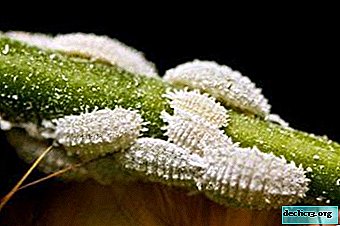 Soapy cotton swab.
Soapy cotton swab.- Sprayed with garlic infusion three times. 5 garlic cloves are poured with half a liter of boiling water, infused for 4 hours. The infusion is applied to the leaves with a brush.
- A solution of green soap (15 grams of soap and 10 ml of denatured alcohol per liter of water).
- It is processed with alcohol tincture of calendula.
- Spider mite settles on the back of the leaves. From such a neighborhood, they turn brown and are covered with through holes. On lashenalia, these parasites can appear only in the summer. To combat arachnids, acaricides are used: laundry soap or mayticides (JUDO, Spiromesifen).
- Aphid secretes poison, due to which the plant stops growing and is deformed. This most malicious pest can destroy the plant in a few days. There are many popular recipes for fighting aphids, but if the defeat is severe, chemical agents (Admiral, Aktara) and preparations based on biological insecticides (Aktofit, Akarin) are used.
Preventive measures:
- temporary quarantine after purchase;
- regular inspection of the plant for damage;
- keep clean;
- insecticide treatment (Biotlin, Confidant, Mospilan, Fitoverm);
- bathing once a month in running water.
Common growing problems:
- Weak flowering. The reason is the excessively high room temperature.
- Pale coloring of leaves and their wilting. Most likely, this is due to the lack of sunlight and drafts.
- The decay of the stem causes poorly selected soil.
- Stains on leaves and flowers cause an excessive bay of earthen coma.
- Bulb rotting occurs due to poor soil and pot disinfection. The bulb itself could also be spoiled.
- If the plant began to stretch very long - you need to give it more light and reduce the temperature in the room.
Conclusion
In winter, when there is a monotonous white and boring landscape outside, I want to add color to the surroundings. This little island of color and smell, a reminder of the past and a dream about the next summer will be exactly lashenalia - a proud, sun-loving exotic from distant African shores. Get this little sun at home and it will give you joy for a long time.

 The leaf stalk is separated from the base just below the level of the substrate, cut at the base or cut in half.
The leaf stalk is separated from the base just below the level of the substrate, cut at the base or cut in half. Soapy cotton swab.
Soapy cotton swab.